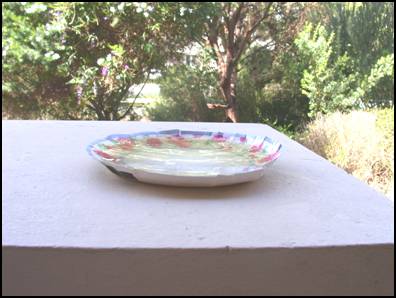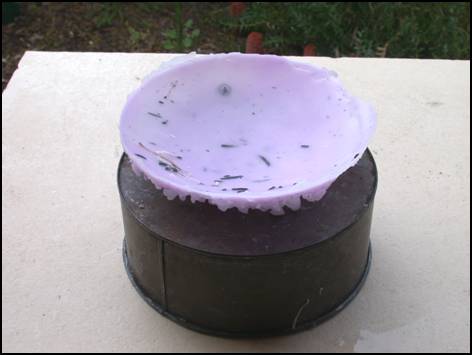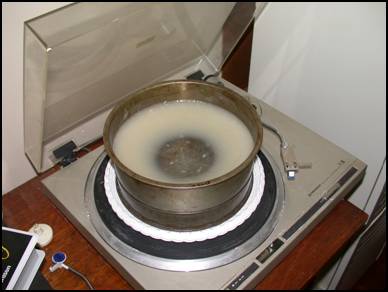Using Spinning Liquids to Simplify
the Construction of Parabolic Reflectors in Solar Cookers
1. Preliminary testing of materials
Steve Appleyard,
Perth, Western Australia
appleyrd@ozemail.com.au
The use of parabolic reflectors in solar cookers can greatly increase cooking temperatures and reduce cooking times, and these are used in a number of commercially available cookers. However, these cookers are not affordable or readily available in many parts of the world and the technology is only accessible if communities in the areas make their own parabolic reflectors using locally available materials. This is often difficult, as it can take a considerable amount of skill and good workmanship to create an accurate parabolic surface from scratch with limited tools and building materials.
|
|
|
|
Parabolic surface forming on a liquid rotated on a record turntable. |
One possible way of simplifying the construction of reflectors is to use a spinning liquid to help [The astronomy community calls this technique spin-casting]. When a liquid in a container rotates, its surface will adopt a concave parabolic shape to balance the forces acting on it from both gravity and the liquid rotation (the centripetal force). Astronomers use this principle to reduce the amount of material and time required to make large glass reflectors for telescopes, and some telescopes use spinning mirrors of liquid mercury to concentrate light rays from distant galaxies.
Although spinning liquids produce parabolic surfaces with a high level of accuracy, this is not of much use for solar cooking unless there is a way of solidifying the surface so it can be used as a base for a reflector. Two physicists, Mark Dragovan and Don Alvarez of Princeton University, have shown that this can be done by spinning slow-setting epoxy resins on a record turntable from a stereo system at a time when records were still being played on Hi-Fi systems. Their procedure is described on page 116 of the February 1994 edition of “Scientific American”.
Record turntables are almost extinct and are too small to make reflectors more than about 0.5 metre in diameter, but larger parabolic surfaces could be made using pottery wheels or custom-made turntables. The use of epoxy resins is more problematic. They are generally prohibitively expensive to use for making large reflectors, and so alternative solidifying agents are needed using materials that are cheap and widely available.
After testing of a number of readily available household materials on a record turntable, two materials showed promise as cheap solidifying agents to replace epoxy resins: gelatine and melted wax.
 |
|
Parabolic surface on gelatine that was spun on a record
|
Gelatine gave the best results when a very concentrated solution (about 3 tablespoons of unflavoured gelatine for each 125 mL of hot water) was spun at 45 RPM on a turntable for 2-3 hours. This procedure produced a very high quality parabolic surface, but the gelatine then had to be cured in a cool dry place for several days before it was sufficiently hard that it could be used as a base for a parabolic reflector. The gelatine has to be dried carefully as its surface commonly crazes or cracks if dried too quickly. While damp, gelatine is also susceptible to attack by microorganisms, although this risk can be reduced if a few drops of eucalyptus oil or oil of cloves is added to the gelatine mix. Further work would have to be carried out to determine the extent to which curing gelatine distorts the parabolic surface.
Of the materials tested, melted wax was by far the best because of its ease of use, the speed at which a good quality surface forms, and because of the reliability of the technique in producing a good quality surface.
Unlike gelatine where the entire liquid body solidifies, the melted wax was poured onto a spinning water surface, and this surface provided a template for the wax to solidify on. Although the wax sets in a few minutes, it will crack due to the upward pressure of the water if the turntable stops rotating immediately. This problem can be overcome by pouring pour ice-cold water onto the wax surface when it has solidified. This helps both harden the wax and reduce the upward water pressure when rotation ceases.
The wax surface could not be used directly as a base for a solar reflector as it will distort if warmed. However, it would be possible to make a plaster cast of the surface and use this to stamp parabolic shapes in other materials (plaster, cement, Paper Mache etc.) that could be hardened to make reflectors. Alternatively, the wax could be replaced by more durable materials by making a mould using the lost wax technique.
Time permitting, I would like to carry out further testing to use spin-casting techniques to make larger parabolic surfaces, and I would like to determine the best ways of making reflectors using these surfaces.
 |
|
|
Parabolic surface on solidified wax after melted
wax was poured onto |
